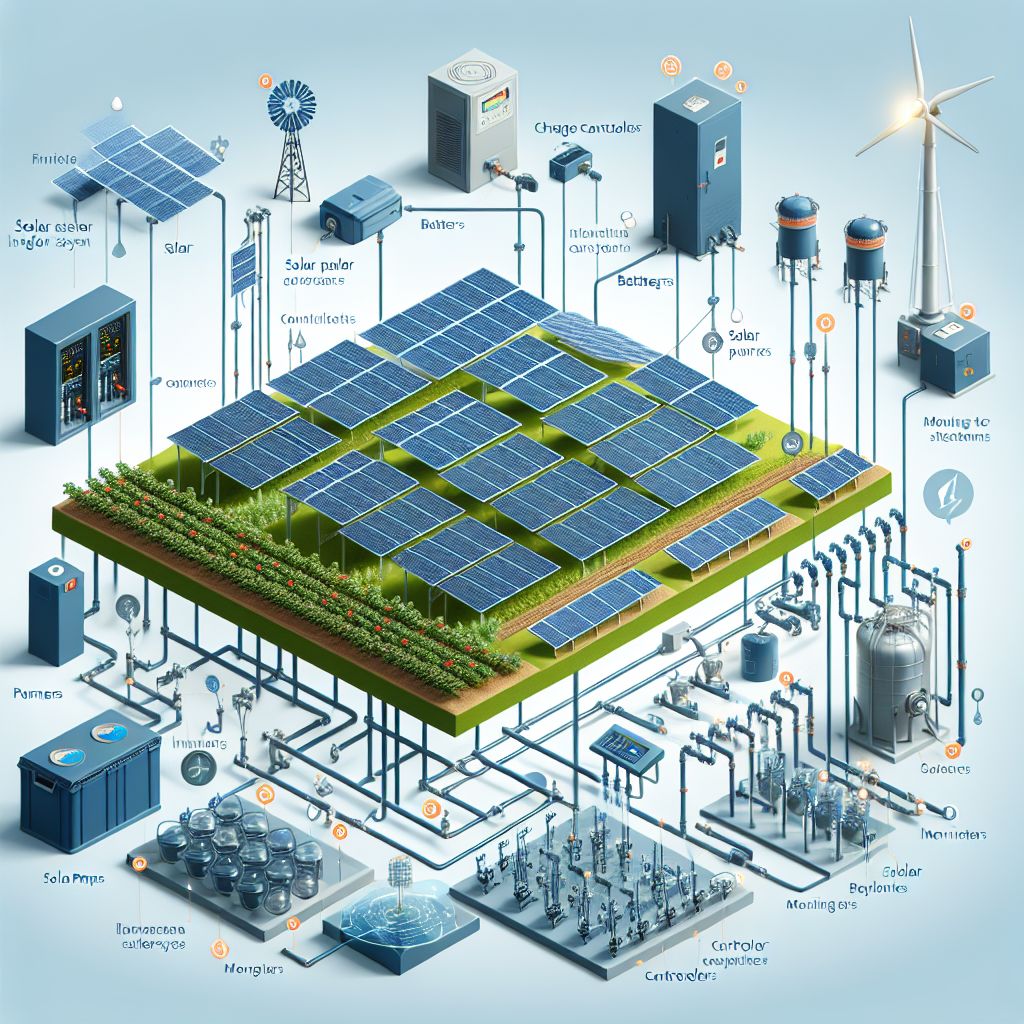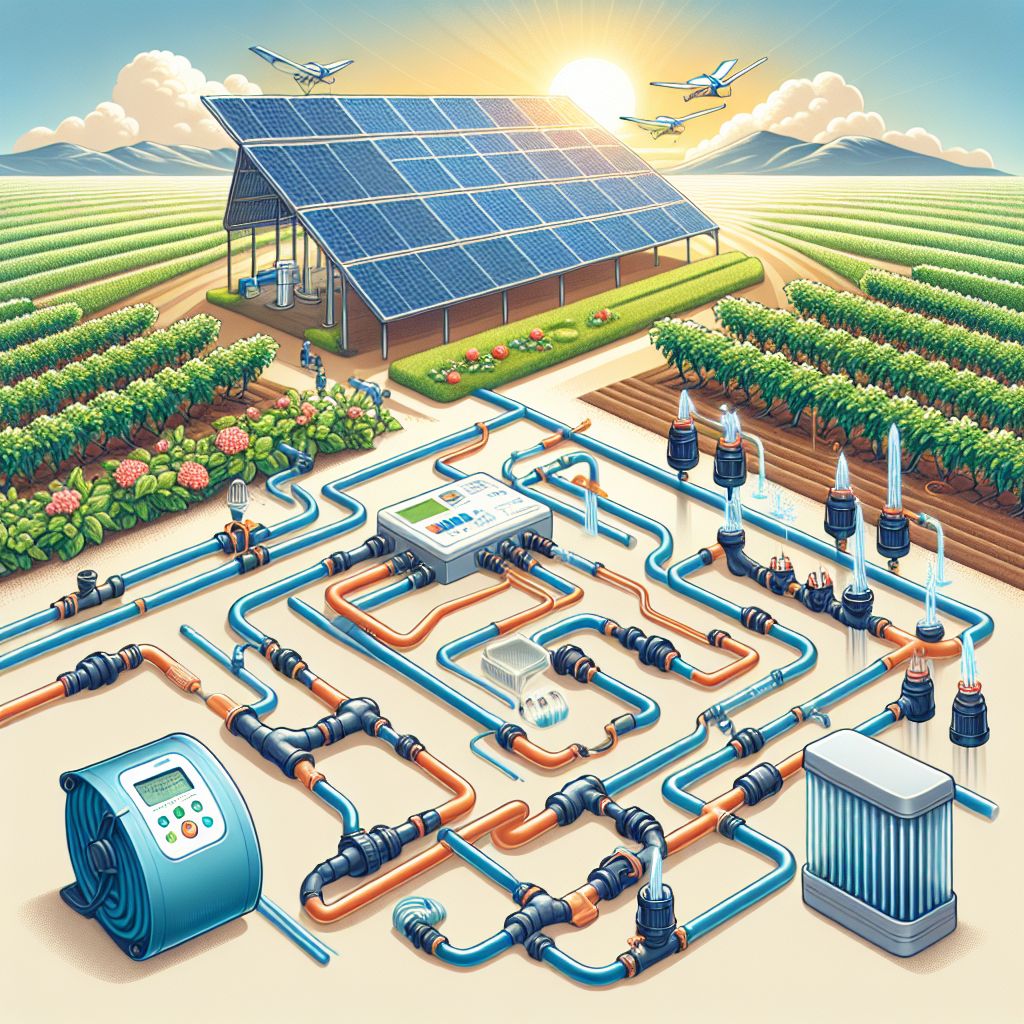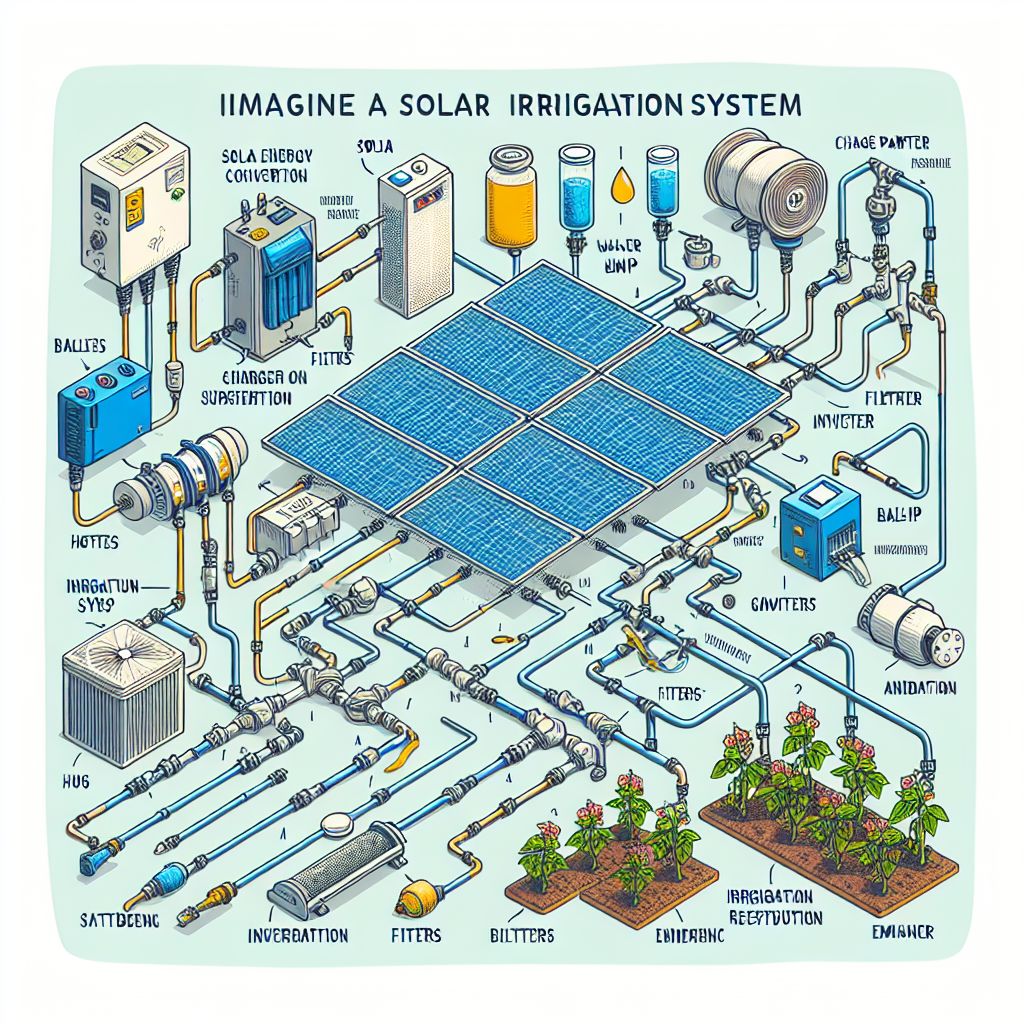
Key Takeaways
Solar irrigation systems are made up of parts that capture and transform solar energy to power water pumps.
The main solar parts include solar panels, charge controllers, batteries, inverters, and mounting systems.
Irrigation parts are improved by solar power, including solar pumps, pipes, hoses, controllers, and emitters.
Using solar irrigation can lower operational costs and contribute to farm sustainability.
It’s important to understand the functionality of each part to optimize the solar irrigation system’s efficiency.
Solar Parts to a Solar Irrigation System
Unpacking Solar Panels: Energy Harvesters
When it comes to harnessing the sun’s power for irrigation, solar panels are your frontline soldiers. Think of them as large, flat collectors that soak up sunlight and transform it into electricity. This electricity is what will eventually run your water pumps, without needing a drop of fuel or a whiff of emissions. Now, not all solar panels are created equal. You’ll find a range of types, from monocrystalline to polycrystalline, and the choice depends on factors like efficiency, cost, and the space you have available.
Here is a table showing the different solar panels that can be used with an irrigation system:
| Panel Type | Pros | Cons |
|---|---|---|
| Monocrystalline | – Highest efficiency in converting sunlight to electricity (around 20%). 1, 2 – Most durable and long-lasting (25+ year lifespan). 1, 2 | – Most expensive upfront cost. 1, 2 |
| Polycrystalline | – More affordable than monocrystalline. 1, 2 – Good efficiency, though lower than mono (around 15-17%). 2 | – Lower efficiency and shorter lifespan than monocrystalline. 1, 2 |
| Thin-Film | – Lightweight and flexible for unique installations. 1, 2 – Can be integrated into building materials. 2 – Lowest manufacturing costs. 3 | – Lowest efficiency (around 7-13%). 1, 2 – Shorter lifespan than crystalline panels. 1 |
Charge Controllers: The Power Managers
After harnessing solar energy, it’s crucial to manage it effectively. This is where charge controllers become important. These devices ensure your batteries are charged as efficiently as possible, avoiding overcharging and potential damage. They act as the gatekeepers of your solar system, permitting the correct amount of energy to flow through at any given moment.
Imagine them as intelligent supervisors, always making choices to preserve the health and longevity of your batteries. In the realm of solar irrigation, maintaining your batteries in excellent condition is critical because they guarantee your pumps continue to function even when the sun isn’t shining.
Batteries: Your Sunlight Storage Solution
Batteries serve as your energy bank. They save the power that your solar panels produce during the day, allowing you to continue irrigating your crops after the sun goes down or on overcast days. Deep-cycle batteries are commonly used in these systems because they can be discharged and recharged repeatedly.
Inverters: Turning Sunlight into Power You Can Use
Think of inverters as the interpreters of your solar system. They take the direct current (DC) electricity that your batteries store and convert it into alternating current (AC), which is what most irrigation pumps need to operate. This step is critical because it ensures that the energy your panels produce can actually perform the work you need it to.
Mounting Systems: The Unsung Heroes of Solar Irrigation
While the mounting system may not be the most exciting aspect of your solar irrigation system, it is certainly one of the most crucial. This component is responsible for securely attaching your solar panels to the ground or your roof, all while ensuring they are perfectly angled to capture the most sunlight possible. Without a reliable mounting system, your panels may not perform as well as they could, or even worse, they could be damaged by weather conditions.
Keep in mind, the orientation and tilt of your panels can significantly impact the amount of energy they generate. So, it’s worth spending some time to get this aspect correct – your crops (and your bank account) will appreciate your efforts.

Components of an Irrigation System
So, how do we use the electricity generated by solar panels to actually irrigate your crops? This is where the irrigation components of your system come into play.
Pipes and Hoses: The Blood Vessels of Irrigation
Pipes and hoses are the veins and arteries of any irrigation system, whether it’s solar-powered or not. They’re the conduits that carry water from its source to your parched plants. In a solar irrigation system, you’ll want to use materials that are tough enough to stand up to the sun’s heat and any other weather conditions they might encounter. PVC or polyethylene pipes are commonly used by farmers because they’re strong, they don’t rust, and they can handle a lot of water pressure.
Here’s a helpful hint: As you’re setting up your pipes and hoses, try to avoid any unnecessary bends and turns. This will help reduce the amount of pressure loss, which means your solar pump won’t have to work as hard to push water through the system. It’s all about making the system as efficient as possible, and the straighter the path, the better.
Irrigation Controllers: The Command Center of Your System
Irrigation controllers are the intelligent technology behind your watering system. They allow you to automate the irrigation process, so you can simply set it up and then leave it alone. This gives you the freedom to focus on other farm tasks while your controller takes care of making sure your crops are watered properly and at the right times.
Let’s take a farmer named John as an example. He used to water his crops manually, spending hours every day. After installing an irrigation controller, he simply sets up the watering schedule once and the system does the rest. It’s not just convenient; it saves a significant amount of water and energy too.
Controllers can be simple timers or more advanced systems that monitor soil moisture levels and adjust watering accordingly. The latter is particularly useful for solar irrigation systems, as it ensures that you’re using that precious solar energy in the most efficient way possible.
Emitters: Watering the Plants Directly at Their Roots
Emitters are the final destination of your irrigation system, where the water eventually reaches the plant. They are available in several types, including drippers, sprayers, and soaker hoses, each of which is designed to meet different irrigation requirements. Drippers, for instance, are ideal for delivering water directly to the base of a plant, reducing evaporation and increasing water efficiency – an essential feature of any solar-powered system.
Here is a table showing the different irrigation systems and the pros and cons of each
| Irrigation System | Pros | Cons |
|---|---|---|
| Drip Irrigation | – Minimizes water loss through evaporation. 1, 2, 3 – Delivers water directly to root zone. 1, 2, 3 – Reduces weed growth. 1 – Customizable flow rates. 3 | – Time-consuming installation. 3 – Requires maintenance to prevent clogging. 2, 3 |
| Sprinkler Irrigation | – Covers large areas quickly. 2, 3 – Can be automated. 3 – Suitable for various plants. 3 | – Can lead to overwatering and runoff. 2, 3 – Promotes plant diseases by wetting leaves. 3 |
| Flood/Surface Irrigation | – Covers large areas quickly. 3 – Inexpensive and easy to install. 3 | – Wasteful with high water loss. 2, 3 – Can cause soil erosion and water pollution. 3 – Not suitable for precise moisture needs. 3 |
| Subsurface Irrigation | – Water delivered directly to roots. 3 – Minimizes evaporation. 3 | – Expensive installation. 3 – Potential for clogging. 3 |
Filters: Preventing Blockages for a Smooth-Running System
Just as you wouldn’t want your arteries blocked, you don’t want your irrigation system choked up with debris. Filters are crucial for preventing dirt, sand, and other particles from contaminating your water supply and causing blockages in your emitters. A blockage-free system is an efficient system, and when you’re depending on solar power, efficiency is key.

How Solar Irrigation Systems Work
To understand how a solar irrigation system works, you first need to understand how the components interact with each other. The solar panels produce electricity, which then flows through the charge controller. The charge controller either charges the batteries or powers the inverter. The inverter then converts the electricity into a form that the irrigation pump can use.
The pump draws water through the filters, pushes it through the tubes and hoses, and then the emitters distribute it to your crops. The irrigation controller manages the entire process, ensuring everything runs according to schedule and the needs of your crops.
Advantages of Implementing Solar Irrigation Systems
Solar irrigation systems bring a wealth of advantages. They’re eco-friendly, utilizing the sun’s renewable energy, and they decrease your energy costs. As they don’t depend on fossil fuels, they also lower your carbon emissions, which is a significant benefit for the planet.
Saving Money with Solar Power
Let’s get down to brass tacks. You might have to shell out more money upfront for a solar irrigation system than you would for a traditional one, but the operating costs are much less. You won’t be forking over cash for electricity or diesel to power your pumps – the sun takes care of that, and it doesn’t cost a dime.
In the long run, the savings from this system can accumulate and eventually pay for the cost of the system itself. Moreover, since it has fewer moving parts compared to a conventional irrigation system, there are fewer parts that can malfunction, thereby reducing maintenance costs.
Improving Farm Sustainability with Solar Irrigation Systems
Sustainability is not just a catchphrase; it’s a pledge to farming methods that do not exhaust resources or damage the environment. By implementing a solar irrigation system, you are making a significant move towards a more sustainable business. You are using less water, producing fewer emissions, and you are demonstrating a model for responsible land management.
Don’t overlook the possibility of higher crop yields. With accurate and steady irrigation, your crops receive exactly what they need to flourish. Healthier crops lead to a healthier harvest, which is beneficial to your profit margin.
Endurance and Minimal Upkeep
Solar irrigation systems are designed to endure. Solar panels, for instance, can continue to produce electricity for a quarter of a century or longer. And because solar pumps have fewer moving parts than conventional pumps, they’re less prone to malfunction, which means you spend less time on repairs and more time on cultivation.
However, like all systems, they need some maintenance. The good news is that maintenance is usually quite simple: keeping the panels clean, checking the connections, and monitoring the performance of the system. A little regular care can help your solar irrigation system run smoothly for many years.
Make sure to clean your solar panels regularly to ensure they’re working at their best.
Every few months, check your batteries to ensure they’re charging properly and not showing any signs of damage.
With each season, check your irrigation controller settings to adjust for changing water needs.
Conclusion:
Incorporating a solar irrigation system is an investment in the future of agriculture. It’s a step towards independence, sustainability, and resilience. By understanding each component and its function, farmers can optimize their systems for maximum efficiency and benefit. The sun’s power is a resource that’s accessible to nearly every farmer, and with the right setup, it can be utilized to lower costs, conserve resources, and grow healthier crops. Solar irrigation is not just about technology; it’s about a sustainable and prosperous future for agriculture.
Common Questions
Farmers often have a number of questions when considering the switch to solar irrigation. They may wonder about the cost, how big the system needs to be, how it operates, how to maintain it, and what kind of incentives are available. Here are some answers to these common questions.
What is the average price of a solar irrigation system?
The price of a solar irrigation system can fluctuate greatly depending on the size of the system, the kind of pumps and panels used, and the unique requirements of your farm. As a rule of thumb, you can anticipate spending anywhere from a couple thousand dollars for a small system to several tens of thousands for larger farms. Nonetheless, it’s crucial to consider the long-term savings on energy bills, which can counterbalance the upfront cost over time.
How Can I Choose the Proper Solar Panel Size for My Irrigation System?
Choosing the right size for your solar panels is key to ensuring they can handle your irrigation needs. First, figure out how many watts your irrigation pumps need in total. Then, think about how many hours of sunlight your area gets on average and how efficient the solar panels you’re looking at are. It can be helpful to talk to a solar provider who can look at your specific situation and suggest a system that fits your farm’s needs.
Let’s say your pump needs 500 watts and you get about 5 hours of sun each day. You’ll need panels that can make at least 100 watts for every hour of sun. But you should add a little extra to make up for times when the weather isn’t great.
Do Solar Irrigation Systems Work on Cloudy Days?
Absolutely, solar irrigation systems do work on cloudy days, but they may not work as efficiently. This is why batteries are so important. A good system will have enough battery power to store energy on sunny days and use it on cloudy days. You could also have a hybrid system that can switch to another power source if needed.
In case you reside in a place where cloudy days are a common occurrence, you might need to add more solar panels and battery storage to maintain a steady power supply.
What Kind of Upkeep is Needed for Solar Irrigation Systems?
Solar irrigation systems usually require little maintenance, such as cleaning the solar panels, inspecting the connections, and making sure the batteries are working as they should. It’s a good idea to check the system often to keep it working at its best and to avoid any possible problems.
For example, solar panels should be kept clean of dust and debris to avoid a decrease in efficiency. Batteries should be checked to make sure they’re holding a charge, and connections should be checked for corrosion or wear.
Do Governments Offer Incentives or Subsidies for Solar Irrigation Systems?
A number of governments globally offer incentives or subsidies to encourage farmers to adopt solar technology. These can range from tax incentives, grants, low-interest loans, or rebates. The details can vary depending on the country or region, so it’s important to investigate what’s available in your area.
In the United States, for instance, the Rural Energy for America Program (REAP) offers monetary support to agricultural producers and small rural businesses for renewable energy systems, including solar irrigation.







Leave a Reply